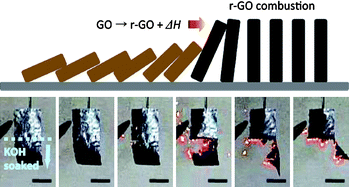Chemically modified graphene: flame retardant or fuel for combustion?†
Abstract
Graphene oxide (GO), an oxidized form of

- This article is part of the themed collection: Chemically Modified Graphenes
* Corresponding authors
a
Research Center for Applied Sciences, Academia Sinica, Taipei, Taiwan
E-mail:
lanceli@gate.sinica.edu.tw
Fax: +886 35734217
Tel: +886 35169135
Graphene oxide (GO), an oxidized form of

 Please wait while we load your content...
Something went wrong. Try again?
Please wait while we load your content...
Something went wrong. Try again?
Y. Shi and L. Li, J. Mater. Chem., 2011, 21, 3277 DOI: 10.1039/C0JM02953J
To request permission to reproduce material from this article, please go to the Copyright Clearance Center request page.
If you are an author contributing to an RSC publication, you do not need to request permission provided correct acknowledgement is given.
If you are the author of this article, you do not need to request permission to reproduce figures and diagrams provided correct acknowledgement is given. If you want to reproduce the whole article in a third-party publication (excluding your thesis/dissertation for which permission is not required) please go to the Copyright Clearance Center request page.
Read more about how to correctly acknowledge RSC content.
 Fetching data from CrossRef.
Fetching data from CrossRef.
This may take some time to load.
Loading related content
